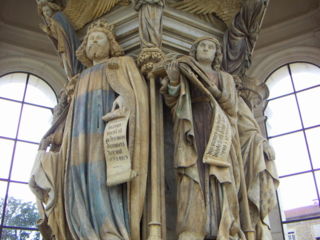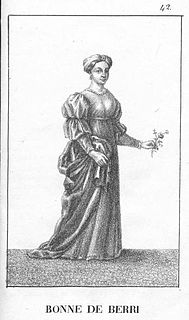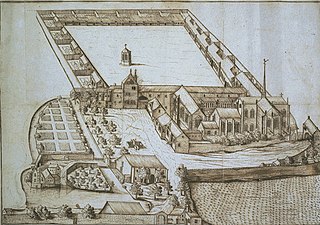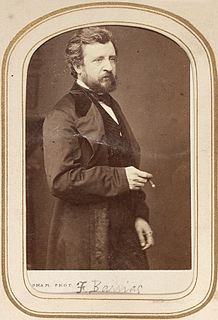Career
The Jean or Hennequin de Marville who worked on the tomb of Philip the Bold has been identified with the Jean de Menreville who was named in 1366 as working on the church of Saint-Pierre at Lille. He is named as working in Rouen Cathedral in 1369, where he helped decorate the chapel of the king's heart at the command of King Charles V of France. He joined the service of Philip the Bold on 22 January 1372 as ymagier et valet de chambre de Monseigneur. [lower-alpha 1] The next year he moved to Dijon on the command of the Duke. An account from 27 January 1377 records the purchase of 26 pounds of ivory for Mainreville, tailleur de menues oeuvres. Based on this an ivory figure of the Trinity in the Museum of Fine Arts, Houston may be attributed to him.
Jean de Marville created an important school of sculpture. Claus Sluter was the most noted member. Sluter's nephew Claus de Werve was another member of this school. Lesser sculptors of this school were Jehan de la Huerta and Antoine le Moiturier. Claus Sluter (c. 1360 - 1405), a sculptor from Harlem in the Netherlands, joined Jean de Marville's studio in 1383. At that time de Marville was directing the construction and decoration of the Chartreuse of Champanol, which was to be the Duke's burial place. The image of the virgin and child in the center pillar of the monastery's chapel is attributed to either Marville or Sluter.
On 29 March 1381 Marville was charged by the Duke with making an alabaster sepulcher for him in Dijon, and the work was started in October 1384. Sluter succeeded Jean de Marville as ymagier when he died in 1389. There seems little doubt that the bulk of the work was done by Sluter, or under Sluter's direction, since it was not completed until 1404. [lower-alpha 2] The tomb is unusual in being decorated with free-standing statues of monks, clergy and laity rather than the conventional relief figures. This concept may have been Marville's, but could have been a change introduced by Sluter when he took charge of completing the project.

Claus Sluter was a Dutch sculptor. He was the most important northern European sculptor of his age and is considered a pioneer of the "northern realism" of the Early Netherlandish painting that came into full flower with the work of Jan van Eyck and others in the next generation.

Philip the Bold was Duke of Burgundy and jure uxoris Count of Flanders, Artois and Burgundy. He was the fourth and youngest son of King John II of France and Bonne of Luxembourg. Philip was the founder of the Burgundian branch of the House of Valois. His vast collection of territories made him the undisputed premier peer of the Kingdom of France and made his successors formidable subjects, and later rivals, of the kings of France.

Robert II of Burgundy was Duke of Burgundy between 1272 and 1306. Robert was the third son of duke Hugh IV and Yolande of Dreux.

René II was Count of Vaudémont from 1470, Duke of Lorraine from 1473, and Duke of Bar from 1483 to 1508. He claimed the crown of the Kingdom of Naples and the County of Provence as the Duke of Calabria 1480–1493 and as King of Naples and Jerusalem 1493–1508. He succeeded his uncle John of Vaudémont as Count of Harcourt in 1473, exchanging it for the county of Aumale in 1495. He succeeded as Count of Guise in 1504.

Robert II of Dreux, Count of Dreux and Braine, was the eldest surviving son of Robert I, Count of Dreux, and Agnes de Baudemont, countess of Braine, and a grandson of King Louis VI of France.
Archambaud IX of Bourbon, called "Le Jeune", was a ruler (sire) of Bourbonnais in the modern region of Auvergne, France.

Joan of Burgundy, also known as Joan the Lame, was Queen of France as the first wife of King Philip VI. Joan ruled as regent while her husband fought on military campaigns during the Hundred Years' War: 1340, 1345-1346 and 1347.

Bonne of Berry was the daughter of John, Duke of Berry, and Joanna of Armagnac. Through her father, she was a granddaughter of John II of France.

Château de Germolles is situated in Burgundy, not far from Beaune and Chalon-sur-Saône. It is the best preserved residence of the Dukes of Burgundy. Built during the second part of the 14th century, this château is important for the history of the region. Furthermore, it is a rare example of such a well-preserved residence in France in the 14th and the beginning of the 15th centuries, when most of the princely palaces of that period have almost entirely disappeared. This exceptional site evokes court life in France on the eve of the Renaissance.

The Chartreuse de Champmol, formally the Chartreuse de la Sainte-Trinité de Champmol, was a Carthusian monastery on the outskirts of Dijon, which is now in France, but in the 15th century was the capital of the Duchy of Burgundy. The monastery was founded in 1383 by Duke Philip the Bold to provide a dynastic burial place for the Valois Dukes of Burgundy, and operated until it was dissolved in 1791, during the French Revolution. Called "the grandest project in a reign renowned for extravagance", it was lavishly enriched with works of art, and the dispersed remnants of its collection remain key to the understanding of the art of the period.

Édouard Joseph Dantan was a French painter in the classical tradition. He was widely recognized in his day, although he was subsequently eclipsed by painters with more modern styles.
Mar Ishodad of Merv was a bishop of Hdatta and prominent theologian of the Church of the East, best known for his Commentaries on the Old and New Testaments.

Antoine Le Moiturier (1425–1495) was a French sculptor.

Félix-Joseph Barrias was a French painter. He was well known in his day for his paintings of religious, historical or mythical subjects, but has now been largely forgotten. Artists who trained in his studio and went on to achieve fame include Edgar Degas, Gustave Achille Guillaumet and Henri Pille.
Charles-Simon Pradier was a Swiss engraver who also worked in France and Brazil. He was recognized as one of the leading engravers of his day. He collaborated with Jean Auguste Dominique Ingres on several works.

Jean de la Huerta was a Spanish sculptor of Aragonese origin. Most of his work was produced in the duchy of Burgundy.
Pierre-François Berruer was a French sculptor. He is known for the twelve statues that decorate the front of the Grand Théâtre de Bordeaux.

Ermentrude de Roucy (Irmtrude) was a Countess and Duchess of Burgundy.
Arthur Kleinclausz was a French medieval historian, best known for his work associated with the histories of Burgundy, Lyon and of the Carolingian era.

The Tomb of Philip the Bold is a funerary monument commissioned by the Duke of Burgundy Philip the Bold for his burial at the Chartreuse de Champmol, a Carthusian monastery on the outskirts of Dijon, in today's France. Preparing for his death and succession, Philip commissioned the work in c. 1380, some 14 years before his actual passing.
















